Even though today’s society teaches us to avoid high-calorie foods and look for ones that are lighter and less “fattening”, in an emergency situation you don’t want to be caught with just soup in your backpack. High-calorie foods are important for our energy levels and it’s always best to store some of the healthiest in our survival pantry. You never know when a disaster strikes and you need lots of energy and strength to protect your family from harm and save others.
Make no mistake; we’re not talking about cheeseburgers and French fries here! These are also high-calorie foods but they won’t help you in an SHTF scenario. Fried foods and those that have a high content of calories from sugar and other vegetable grease and oils are not exactly healthy and they are not assimilated well by our system.
This leads to problems in processing and deposits of adipose tissue on our bodies making us heavier. Healthy foods that have a high-calorie count are easily processed by our digestive system and help maintain our energy levels to the maximum for a longer period of time.

This is why the subject of healthy food with high-calorie content is actually very popular amongst preppers. It is important to make the difference between food that will make you fat and slow and nutritious food that will give you the necessary strength to climb the final part of the mountain.
Nuts and seeds
Small, but packed with lots of nutrients, fibers, and proteins nuts and seeds are small caloric bombs for our system. They are usually easy to ingest and the stomach doesn’t have any problems breaking them in various nutrients and vitamins and integrating them into our energy storage. Nuts and seeds contain good fats and they are packed in high protein and antioxidants (in some cases). Most nuts and seeds contain healthy oils that are beneficial for the heart, in the right quantity. They are also very helpful in reaching the satiety level due to their high content of fiber.
Attention: Make sure to check if you’re not allergic before trying something new! We all know that peanut allergies exist so get tested first.
Let’s take a look at the calorie intake per type of nuts and seeds and see which are the ones that weigh the most (calorie-wise).
| Nuts / seeds | Calories / ounce (28g) | Calories / 100g |
| Walnuts | 183 | 654 |
| Hazelnuts | 181 | 628 |
| Almonds | 162 | 575 |
| Pistachios | 159 | 557 |
| Peanuts | 164 | 567 |
| Macadamia Nuts | 201 | 718 |
| Pecans | 199 | 691 |
| Pine Nuts | 188 | 673 |
| Desiccated Coconut | 185 | 632 |
| Sunflower Seeds | 164 | 585 |
| Cashew Nuts | 161 | 553 |
| Pumpkin & Squash Seeds | 161 | 446 |
| Watermelon Seeds | 156 | 158 |
| Flaxseeds | 150 | 534 |
| Chia Seeds | 136 | 486 |
| Brazil Nuts | 184 | 656 |
When it comes to nutritional values, seeds and nuts vary according to the type of fat and level of fiber and proteins they contain. For example, Almonds contain the most fibers (12g/100g), and together with peanuts and pistachios they contain the most proteins. On the other hand, Macadamia nuts and Brazil nuts contain the most saturated fat which makes them the best for your heart.
Attention: Remember that we’re discussing nuts in their raw form here. Processing by roasting changes the types of fat into trans fat which is damaging for our internal organs.
How to store them for emergency situations
Now that you know about caloric and fiber contents, it’s time to learn how to properly store seeds and nuts in your emergency pantry. It’s important to have some in your storage and they are quite sensitive so don’t ignore this advice.
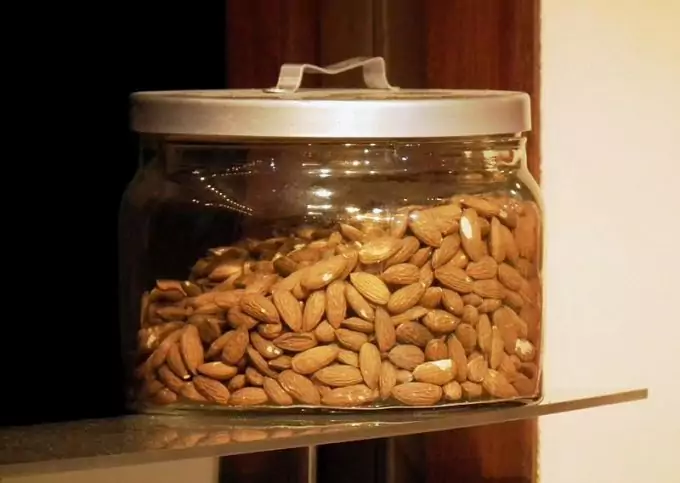
The better way to store these foods is in air-tight containers that don’t allow humidity to go through and help in preserving the oils they contain. In humidity or improper storage, these oils become rancid and your precious cargo will be worthless. The most recommended container for this is a Mason jar or anything that resembles it. It’s always better to keep them in glass containers as nuts and seeds have the property of absorbing surrounding odors. This will change the taste and texture.
Storage conditions are also very important because when and if exposed to too much light or heat, the oils will go rancid. This is why nuts and seeds must be kept in a dry, dark, and cool place until you are ready to use them. The storage room temperature must be less than 70 F.
Another way to keep your seeds and nuts safe is in a refrigerator or in the freezer. They will last longer and you’ll have them at hand all year long.
How to take them with you on hikes and outdoor adventures
Nuts and seeds are extremely nutritious and they are perfect for that boost of energy when you feel like lying down and giving it up. This is why hikers and outdoor enthusiasts like to always have a small number of seeds and nuts in their backpacks at all times. Now you can either take them as they are or you can combine them in various energetic bars that occupy less space and pack more calories.
We prepared one simple and easy-to-make bar recipe with seeds and nuts. Just remember that you can add any other ingredients you like and make it unique, just for you.
Delicious energy bar recipe – the name is totally generic, you can call it however you want and, as we already mentioned, you can add other nuts and seeds. The basic ingredients are:
- flax seeds
- pumpkin seeds (break them into pieces if they’re big)
- sunflower seeds
- sesame
- almonds (break them into small chunks)
- honey (2 or 3 teaspoons)
- organic coconut oil (2 or 3 teaspoons)
- vanilla (a few drops)
- cinnamon (one pinch)
- salt (as much as you consider necessary)
The quantities are not exact, as you can see because everyone can add as much or as little from an ingredient as he/she likes. Our recommendation is to start small and make only a few bars first and then continue by improving the recipe after your own taste.
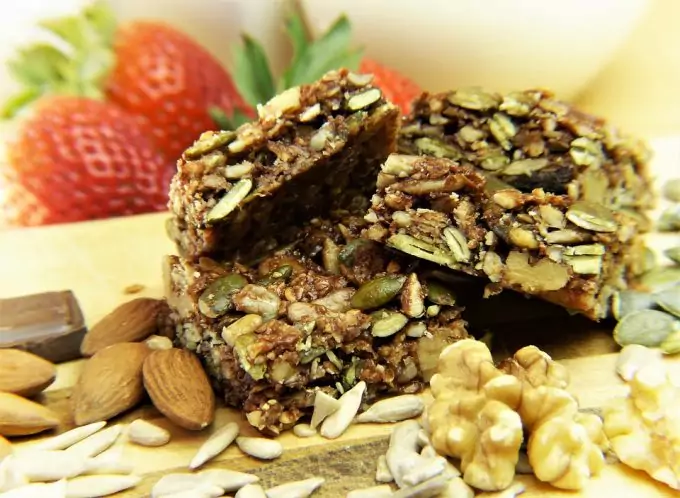
The preparation method is simple: mix all the seeds and nuts together, add honey and oil and stir until everything is bonded in a thick mixture; then add the seasonings. When the mixing process is over, separate it into small quantities (about 1 bar for each pile). Put a sheet of plastic wrap on a clean, flat surface (as much as you’d use for a sandwich) and place a small pile of the mixture on it.
Press the mixture with a spoon or a wide knife to make it flat, in the shape of a bar, and wrap the sheet around it. If you’re not satisfied with the shape, you can continue shaping it with your fingers after it is wrapped. Continue this process with every pile and when everything is finished place them in the refrigerator for a few hours. They will harden and then will be ready to eat.
Two or three of these bars will definitely be enough for a long hike to keep your energy levels up and going.
Dried fruits
Dried fruits are in second place on the list of categories with healthy foods packed with high content of calories. Through the process of dehydration, fruits lose their water content but manage to keep most of the vitamins and sugars, this raising their caloric concentration and fiber content. Actually, scientists discovered that the concentration of antioxidants is doubled in dried fruits in comparison with fresh ones (one more reason to start drying fruits).
See: Best Food Dehydrator: Top 10 Dehydrators on The Market
Just make sure you know how the fruits have been dried or, better yet, you can dry them yourself. Dried fruits that you buy from stores usually have added sugar to enhance the flavor and to protect them from getting spoiled.
| Dried fruit | Calorie per 66g (half a cup) | Content of fibers (g/100g of product) |
| Prunes | 224 | 7 |
| Cherries | 266 | 3 |
| Blueberries | 254 | 10 |
| Pears | 236 | 7 |
| Raisins | 217 | 3.7 |
| Dates | 208 | 9 |
| Apricots | 191 | 7 |
| Peaches | 189 | 7 |
| Cranberries | 185 | 6 |
| Apples | 104 | 8 |
| Lychees | 200 | 4.6 |
| Figs | 186 | 10 |
| Currants | 204 | 9.8 |
In conclusion, dried fruits are high in calories and fibers but they won’t trigger the satiety feeling too soon. The fact that they are small and smell amazing makes us eat as many as possible in one serving and this can’t be good for the organism. Never eat more than one serving (half a cup) if you don’t want to get fat faster. They are indeed small caloric bombs and you need to manage them carefully.
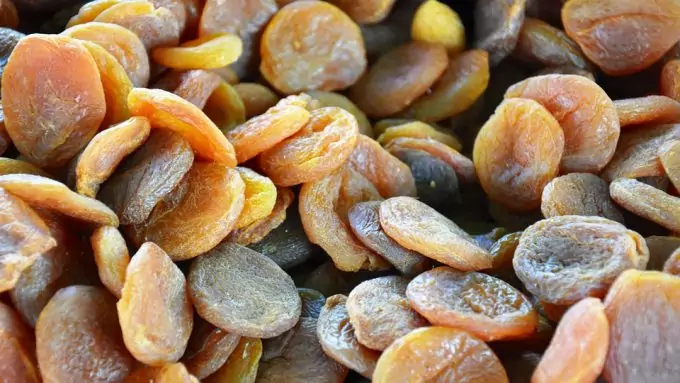
You will be eating healthier if you replace regular sweets and candy with dried fruit but don’t full yourself that because you’re eating healthy there won’t be any consequences. Everything must be eaten in moderation and with consideration towards your body.
Dried fruits are amazing in an emergency situation or in an outdoor adventure when you need that energy boost, and they go great in combination with nuts and seeds. This is why you should include them in your emergency pantry and make sure they are well preserved.
Check out our DIY dehydrated food recipes to give you more options.
Methods to store dried fruits for longer time periods
Regardless of the preparation method (homemade or bought), dried fruits also require special storage conditions. First, if you buy them, make sure the label says “no added sugars or sulfites”; the more natural the better.
These foods are highly susceptible to reabsorbing moisture from the environment and insects (mostly because insects are attracted by their sweetness). The safest method is freezing them. This way they will last a few years without any problem. Otherwise, you can keep them in your pantry, in an air-tight container. You can use jars you use for canning, plastic containers made for freezing, or vacuum packaging.
Just like with nuts, the storage place must be cool (no more than 60F), dry and dark. This way, you’ll be able to enjoy them for about 6 to 12 months. Make sure to pack everything in small portions. This way, if you open a package the remaining fruits won’t spoil.
Read our informative article on how to dehydrate food to guide you in food preservation.
How to use them in the kitchen
You don’t have to be an extremely creative cook to come up with a few good uses for dried fruits. You can use them as-is, combine them with yogurt or cream and make smoothies, add them to your favorite ice cream, include them in cookie recipes or make energy bars in combination with nuts and seeds.
Fats and oils
Even though they don’t look as appealing as the previous list members we discussed, fats and oils are an important part of our diet. We use these foods for cooking and a diet without them is harmful to our health. Consumed with moderation, good fats and oils help our entire body function properly and maintain good blood cholesterol.
| Fats & oils | Calorie per tablespoon (13g) | Calorie per 100g |
| Walnut Oil | 124 | 884 |
| Almond Oil | ||
| Apricot Kernel Oil | ||
| Hazelnut Oil | ||
| Avocado Oil | ||
| Safflower Oil | ||
| Flaxseed Oil | ||
| Grapeseed Oil | ||
| Sunflower Oil | ||
| Cocoa Butter | ||
| Sesame Oil | ||
| Palm Oil | ||
| Coconut Oil | 121 | 862 |
| Mutton Fat | 117 | 900 |
| Tallow | ||
| Chicken Fat | ||
| Turkey Fat | ||
| Goose Fat | ||
| Butter | 100 | 717 |
| Olive Oil | 124 | 884 |
| Canola Oil | ||
| Peanut Oil | ||
| Soybean Oil |
How to store fats and oils safely
Oils and fats that are stored improperly tend to go rancid pretty fast and all your work and effort invested into collecting them will be for nothing. Getting rancid or oxidizing happens when oils and fats get in contact with air, light, or heat which is why you should keep them in an air-tight container, in a cool, dark, and dry place.
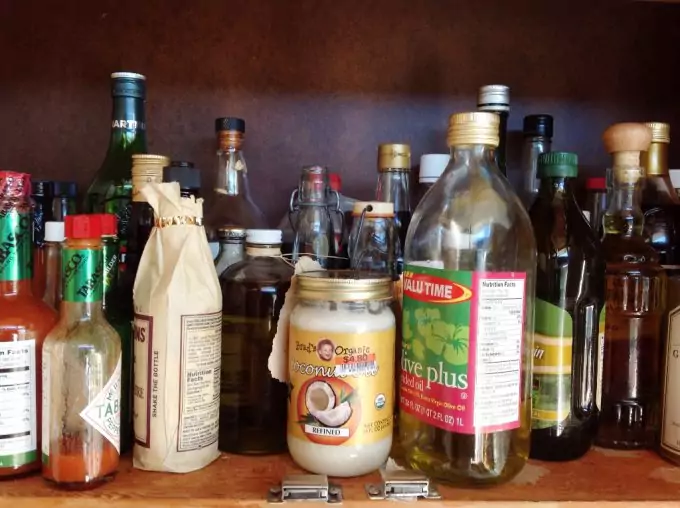
Again, the safest place for storing oils and fats in the refrigerator. Still, you need to make sure the container they are in is perfectly closed, otherwise, they will “borrow” smells from other foods around. In cold temperatures, vegetable oils and fats tend to solidify but this state changes as soon as you get them near a heat source.
Usually, oils that were obtained through cold pressing and remain in their unrefined version don’t resist as much as the refined ones. You shouldn’t try to store unrefined oils for more than 3 to 6 months.
Using fats and oils in the kitchen
There is no secret here as we use them every day in the preparation of our food. Regardless of the fact that we use them for frying or we simply incorporate them in dough and other types of food, fats and oils are irreplaceable.
Milk, dairy & eggs
We consume them every day and yet we still take them for granted. Just because the shops’ shelves are filled with numerous varieties, it doesn’t mean these foods will be just as easy to find in an SHTF scenario. Actually, they will be among the most difficult to find as they are usually the most processed foods in our diet.
Milk comes in a variety of products from plain milk to yogurt, cream, and other varieties when the cheese has a plethora of forms. Eggs on the other hand are just eggs, but in case of an emergency, you would need the birds to get them.
| Cheese, dairy, or eggs | Calories per ounce (28 g) | Calories per 100g |
| Soft Goat’s Cheese | 75 | 268 |
| Hard Goat’s Cheese | 127 | 452 |
| Feta | 74 | 264 |
| Whole Milk | 149 (for a cup) | 496 |
| Buttermilk | 152 (cup) | 387 |
| Ricotta | 108 (1/4 cup) | 174 |
| Greek Yogurt | 99 (per container) | 145 |
| Whey | 28 | 353 |
| Chicken Boiled Egg | 78 per egg | 155 |
Even though a bit packed with calories milk, dairy products, and eggs are among the healthiest protein sources there are. Besides this, each one comes with extra nutrients, calcium, and vitamins that help our system function correctly.
Storing procedures
If you can’t imagine life without a delicious piece of cheese, a cup of milk in the morning, or an egg for breakfast, it’s time to learn how to store them properly for longer periods of time (those that allow this).
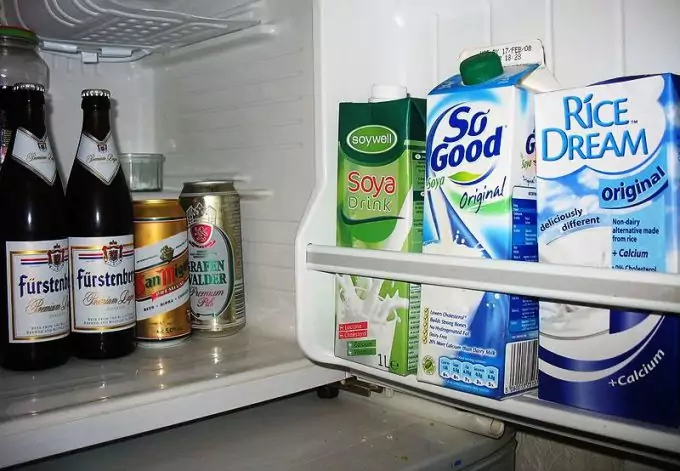
The best way to store these products is in the refrigerator. Dairy, milk, and eggs love cold places, with low humidity and little light. If milk and eggs become a hazard past their expiration dates, dairy products like cheese or smoked cheese can be stored for longer time periods. One way is to buy fresh cheese that hasn’t been processed directly from suppliers and pack it in air-tight containers with salt.
If you don’t have this possibility, buy cheese in batches and don’t open the packaging until you absolutely need to use that cheese.
Milk should be kept in cardboard containers, at a temperature below 40F and consumed 7 days from the opening of the packaging. According to texture, cheese may hold on a little longer after opening. For example:
- soft cheese can last from 2 weeks to 30 days after opening;
- hard cheese lasts 3 to 4 weeks
- Ricotta lasts 5 days.
Eggs should not be kept for more than 3 weeks in the refrigerator and you must make sure they are stored in the coldest area. Boiled eggs may last up to 1 week at low temperatures.
Oily fish
The last decade was somehow awakening for the nutrition industry as oily fish was reintroduced in people’s diets. This type of food is rich in Omega3 fatty acids which are extremely useful for a healthy heart, preventing alcohol-related dementia, and improved mental ability, fighting against cancer, and lowering the risk of having rheumatoid arthritis.
As you can see, even though a bit more caloric than white fish, the oily variety has plenty of benefits for our health. If consumed with moderation, of course.
| Fish | Calorie per 100g (cooked) |
| Mackerel | 262 |
| American Shad | 252 |
| Herring | 203 |
| Halibut | 239 |
| Salmon | 206 |
| Trout | 190 |
| Butterfish | 187 |
| Tuna | 184 |
| Tuna Canned in Oil | 198 |
| Canned Sardines | 208 |
| Canned Anchovies | 210 |
| Pilchards | 105 |
| Kipper | 234 |
| Eel | 293 |
| Whitebait | 283 |
The nutritional values mentioned here and the caloric charge, are considered for fish that have been farmed. For wild species, it’s possible to have smaller values but the difference is not that big. Except for tuna, all the species mentioned in the table above contain healthy Omega3 fatty acids regardless of the preparation method. Tuna only contains Omega3 when fresh; once canned, it loses its properties.
Storing fish for your pantry
Given the fact that in today’s food industry canning is very popular, you can simply buy canned fish (in oil or in tomato juice) and keep it for storage. This type of food has long shelf life (a few years) but it also has to be kept in a cool, dry place. A can must be consumed in a maximum of 3 days since it was opened.
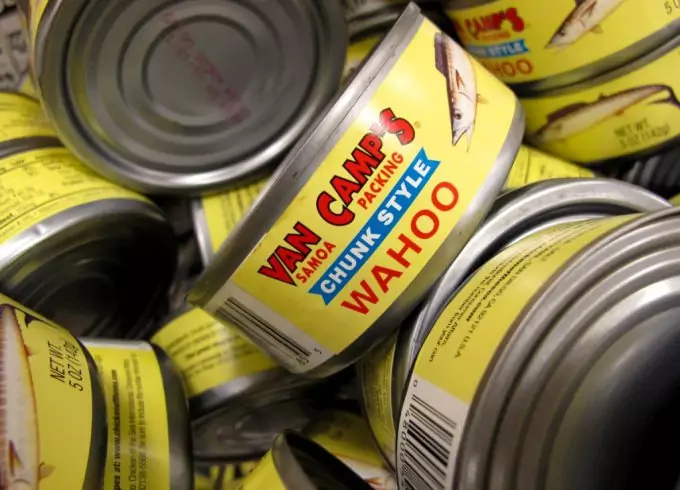
Another method of keeping fish for longer time periods is freezing it. Wrap it in heavy-duty aluminum foil or place it in a plastic freezer container and toss it in.
Butters from nuts and seeds
Another item on our list is occupied by butter made out of nuts or seeds. These are highly caloric and maintain the nutritional values of what they once were. Due to the preparation method and the fact that they are placed in an air-tight container the shelf life is longer and they are not that sensitive to humidity and light.
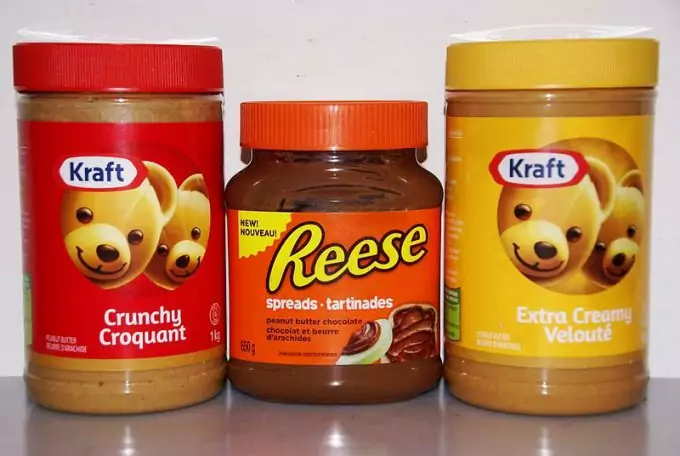
Besides the fact that they are easy to store, this butter don’t require any cooking. They can be applied on bread and consumed as is, allowing you to indulge with a quick snack before a demanding physical job.
| Butter | Calories per tablespoon (16g) | Calories per 100g |
| Peanut butter | 94 | 590 |
| Sunflower Seed Butter | 99 | 579 |
| Almond Butter | 98 | 633 |
| Cashew Butter | 94 | 587 |
| Tahini | 89 | 595 |
Whole grains
The grains that we eat in our bread, in pasta, or in other pastry products are all processed and the external parts are removed. During processing, the hard shell of the grain is removed and only the kernel manages to reach our diet. Whole grains may have a bit more packed, calorie-wise, but they are healthier and contain more fibers thus helping people maintain a stable weight.
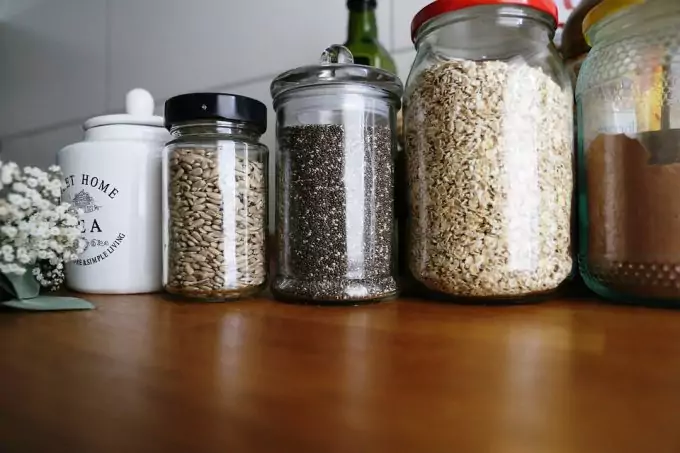
In regards to health, whole grains are known to help with reducing the risk for stroke, type II diabetes, asthma, heart disease, colorectal cancer, and other nasty diseases. So, if you didn’t see their use up until now, we’re sure you are going to refresh and improve your storage of whole grains from now on.
| Whole grain | Calories per 1 cup (about 140g) |
| Teff | 255 |
| Amaranth | 251 |
| Spelt | 246 |
| Kamut Khorasan | 227 |
| Quinoa | 222 |
| Brown Rice | 218 |
| Millet | 207 |
| Pearled Barley | 193 |
| Wild Rice | 166 |
| Buckwheat Groats | 155 |
| Bulgur | 151 |
| Oat Bran | 88 |
Storing grains in the pantry
It’s best to store the grains as they are and not transform them into flour. When whole, they last longer and better. The storage place must be cool and dry and free from any insect contamination. This way, your grains will last up to 6 months.
Avocado
Exotic and filled with nutrients and good fats, the Avocado fruit is amazing for our health. Packing 160 calories per 100g, this amazing fruit also contains fibers and other healthy elements that make it a marvel for our system.
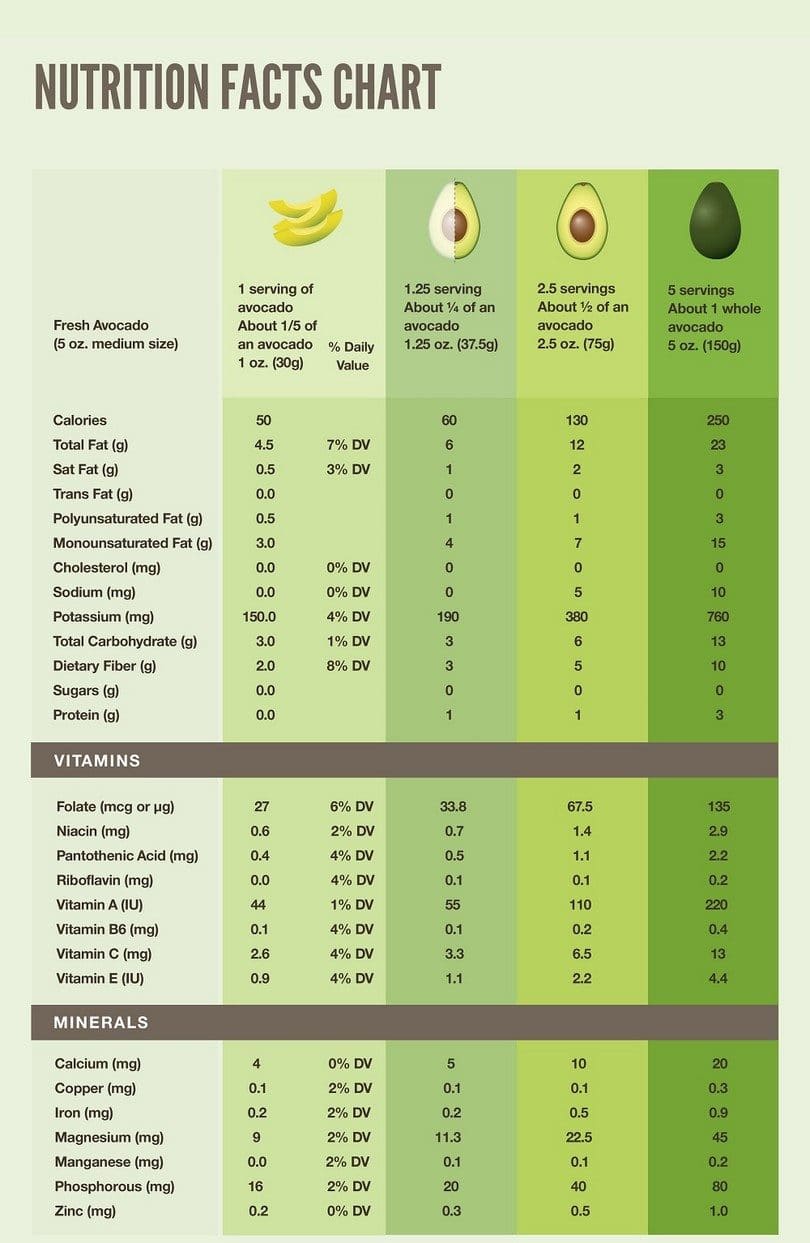
You can store the avocado in the refrigerator for about one week, but only if the fruit hadn’t been cut. For longer storage, you can freeze it as a puree but it will lose some of the texture and nutritive properties.
Dark chocolate
There are countless varieties of chocolate in the world and over 90% of the population won’t be able to live without it so, why not include this fantastic food on our list? Better yet, we are going to include the healthiest form of chocolate: the dark one with 70 to 85% cocoa content. This is the variety that you want to keep close to you in case of a survival situation.
Packed with calories (598 per 100g), proteins, vitamins, and fibers, dark chocolate is the one man-made sweet you are allowed to include in your survival kit. The high cocoa content helps you get full faster and the energy boost will be absolutely amazing.
Meat
The very natural and safe protein source, meat shouldn’t be missing from your menu when facing a difficult situation. Packed with fibers and healthy nutrients, meat is among the hardest food to store for longer periods of time. The best way is to freeze it but you can also can or treat it with smoke and treat it in brine.
| Meat | Calories per 100g |
| Beef | 250 |
| Pork | 121 |
| Turkey | 232 |
| Lamb | 282 |
| Duck | 404 |
| Goose | 161 |
| Veal | 144 |
| Chicken | 237 |
We included the values for ground meat, in its raw state. Of course that, various parts may have slightly different values. Through cooking, you also change the calorie count but these are generic data, to understand the difference between different types of meat and their caloric content.
For more information on how to preserve meat using old and new techniques, see our article on this.
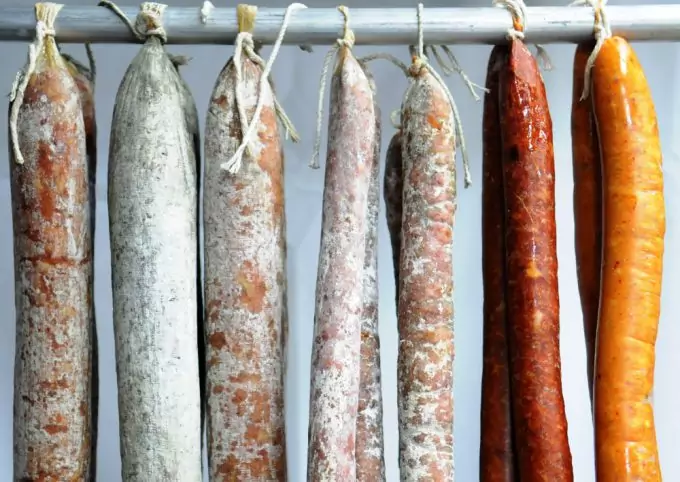
Well, this concludes our list of healthiest food to be eating in an emergency situation when you need lots of energy and power to face difficult times. Just make sure to store them properly and always check your pantry for foods that are about to expire. This way you will be prepared for anything.






Our rule of thumb when it comes to this is that it should be as less salty as possible but as high the nutritional fiber that it can carry. We often bring bananas and trail mix during camping and we find them sufficient in providing us with energy.
The banana is also a great a source of energy too, but you can’t store it for a long time, you have to consume it fast.
Nuts are great! A lot of people use them only as snacks, but they are great in salads and a bunch fo tasty dishes can be made from them too. Most important of all, they are healthy.
It is always good to know what to eat during an emergency.